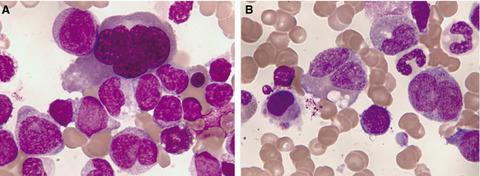当前位置:
X-MOL 学术
›
Cancer Med.
›
论文详情
Our official English website, www.x-mol.net, welcomes your feedback! (Note: you will need to create a separate account there.)
ASXL1 mutation as a surrogate marker in acute myeloid leukemia with myelodysplasia-related changes and normal karyotype.
Cancer Medicine ( IF 4 ) Pub Date : 2020-03-26 , DOI: 10.1002/cam4.2947 Concepción Prats-Martín 1 , Sergio Burillo-Sanz 2 , Rosario M Morales-Camacho 1 , Olga Pérez-López 3 , Milagros Suito 1 , Maria T Vargas 1 , Teresa Caballero-Velázquez 1 , Estrella Carrillo-Cruz 1 , José González 1 , Ricardo Bernal 1 , José A Pérez-Simón 1
Cancer Medicine ( IF 4 ) Pub Date : 2020-03-26 , DOI: 10.1002/cam4.2947 Concepción Prats-Martín 1 , Sergio Burillo-Sanz 2 , Rosario M Morales-Camacho 1 , Olga Pérez-López 3 , Milagros Suito 1 , Maria T Vargas 1 , Teresa Caballero-Velázquez 1 , Estrella Carrillo-Cruz 1 , José González 1 , Ricardo Bernal 1 , José A Pérez-Simón 1
Affiliation

|
Acute myeloid leukemia with myelodysplasia‐related changes (AML‐MRC) are poor outcome leukemias. Its diagnosis is based on clinical, cytogenetic, and cytomorphologic criteria, last criterion being sometimes difficult to assess. A high frequency of ASXL1 mutations have been described in this leukemia. We sequenced ASXL1 gene mutations in 61 patients with AML‐MRC and 46 controls with acute myeloid leukemia without other specifications (AML‐NOS) to identify clinical, cytomorphologic, and cytogenetic characteristics associated with ASXL1 mutational status. Mutated ASXL1 (ASXL1+ ) was observed in 31% of patients with AML‐MRC compared to 4.3% in AML‐NOS. Its presence in AML‐MRC was associated with older age, a previous history of myelodysplastic syndrome (MDS) or myelodysplastic/myeloproliferative neoplasms (MDS/MPN), leukocytosis, presence of micromegakaryocytes in bone marrow, lower number of blasts in bone marrow, myelomonocytic/monocytic morphological features and normal karyotype. ASXL1 mutation was not observed in patients with myelodysplastic syndrome‐related cytogenetic abnormalities or TP53 mutations. Differences in terms of overall survival were found only in AML‐MRC patients without prior MDS or MDS/MPN and with intermediate‐risk karyotype, having ASXL1+ patients a worst outcome than ASXL1− . We conclude that the ASXL1 mutation frequency is high in AML‐MRC patients being its presence associated with specific characteristics including morphological signs of dysplasia. This association raises the possible role of ASXL1 as a surrogate marker in AML‐MRC, which could facilitate the diagnosis of patients within this group when the karyotype is normal, and especially when the assessment of multilineage dysplasia morphologically is difficult. This mutation could be used as a worst outcome marker in de novo AML‐MRC with intermediate‐risk karyotype.
中文翻译:

ASXL1突变是急性髓样白血病的替代标志物,伴有发育异常相关的改变和正常的核型。
伴有骨髓增生异常相关改变(AML-MRC)的急性髓细胞性白血病是不良的预后性白血病。其诊断基于临床,细胞遗传学和细胞形态学标准,有时很难评估最后的标准。在该白血病中已描述了高频率的ASXL1突变。我们对61例AML-MRC患者和46例无其他规范(AML-NOS)的急性髓性白血病对照患者的ASXL1基因突变进行了测序,以鉴定与ASXL1突变状态相关的临床,细胞形态学和细胞遗传学特征。突变的ASXL1(ASXL1 +)在AML‐MRC患者中观察到31%,而AML‐NOS患者为4.3%。它在AML‐MRC中的存在与年龄,骨髓增生异常综合征(MDS)或骨髓增生异常/骨髓增生性肿瘤(MDS / MPN)的既往史,白细胞增多症,骨髓中存在巨核细胞,骨髓中成纤维细胞数量减少,骨髓单核细胞增多有关/单核细胞形态特征和正常核型。 在患有骨髓增生异常综合症相关的细胞遗传学异常或TP53突变的患者中未观察到ASXL1突变。仅在没有既往MDS或MDS / MPN且具有中等风险核型的AML‐MRC患者中发现总生存率方面的差异,ASXL1 +患者的病情比ASXL1−最差。我们得出的结论是,AML-MRC患者的ASXL1突变频率很高,这是因为它的存在与特定特征(包括发育异常的形态征象)相关。这种关联提高了ASXL1作为AML‐MRC中替代指标的可能作用,当核型正常时,尤其是在形态学上难以评估多谱系发育异常时,这可能有助于该组患者的诊断。在具有中等风险核型的新生AML-MRC中,该突变可用作最差的结果标记。
更新日期:2020-03-26
中文翻译:

ASXL1突变是急性髓样白血病的替代标志物,伴有发育异常相关的改变和正常的核型。
伴有骨髓增生异常相关改变(AML-MRC)的急性髓细胞性白血病是不良的预后性白血病。其诊断基于临床,细胞遗传学和细胞形态学标准,有时很难评估最后的标准。在该白血病中已描述了高频率的ASXL1突变。我们对61例AML-MRC患者和46例无其他规范(AML-NOS)的急性髓性白血病对照患者的ASXL1基因突变进行了测序,以鉴定与ASXL1突变状态相关的临床,细胞形态学和细胞遗传学特征。突变的ASXL1(ASXL1 +)在AML‐MRC患者中观察到31%,而AML‐NOS患者为4.3%。它在AML‐MRC中的存在与年龄,骨髓增生异常综合征(MDS)或骨髓增生异常/骨髓增生性肿瘤(MDS / MPN)的既往史,白细胞增多症,骨髓中存在巨核细胞,骨髓中成纤维细胞数量减少,骨髓单核细胞增多有关/单核细胞形态特征和正常核型。 在患有骨髓增生异常综合症相关的细胞遗传学异常或TP53突变的患者中未观察到ASXL1突变。仅在没有既往MDS或MDS / MPN且具有中等风险核型的AML‐MRC患者中发现总生存率方面的差异,ASXL1 +患者的病情比ASXL1−最差。我们得出的结论是,AML-MRC患者的ASXL1突变频率很高,这是因为它的存在与特定特征(包括发育异常的形态征象)相关。这种关联提高了ASXL1作为AML‐MRC中替代指标的可能作用,当核型正常时,尤其是在形态学上难以评估多谱系发育异常时,这可能有助于该组患者的诊断。在具有中等风险核型的新生AML-MRC中,该突变可用作最差的结果标记。



























 京公网安备 11010802027423号
京公网安备 11010802027423号